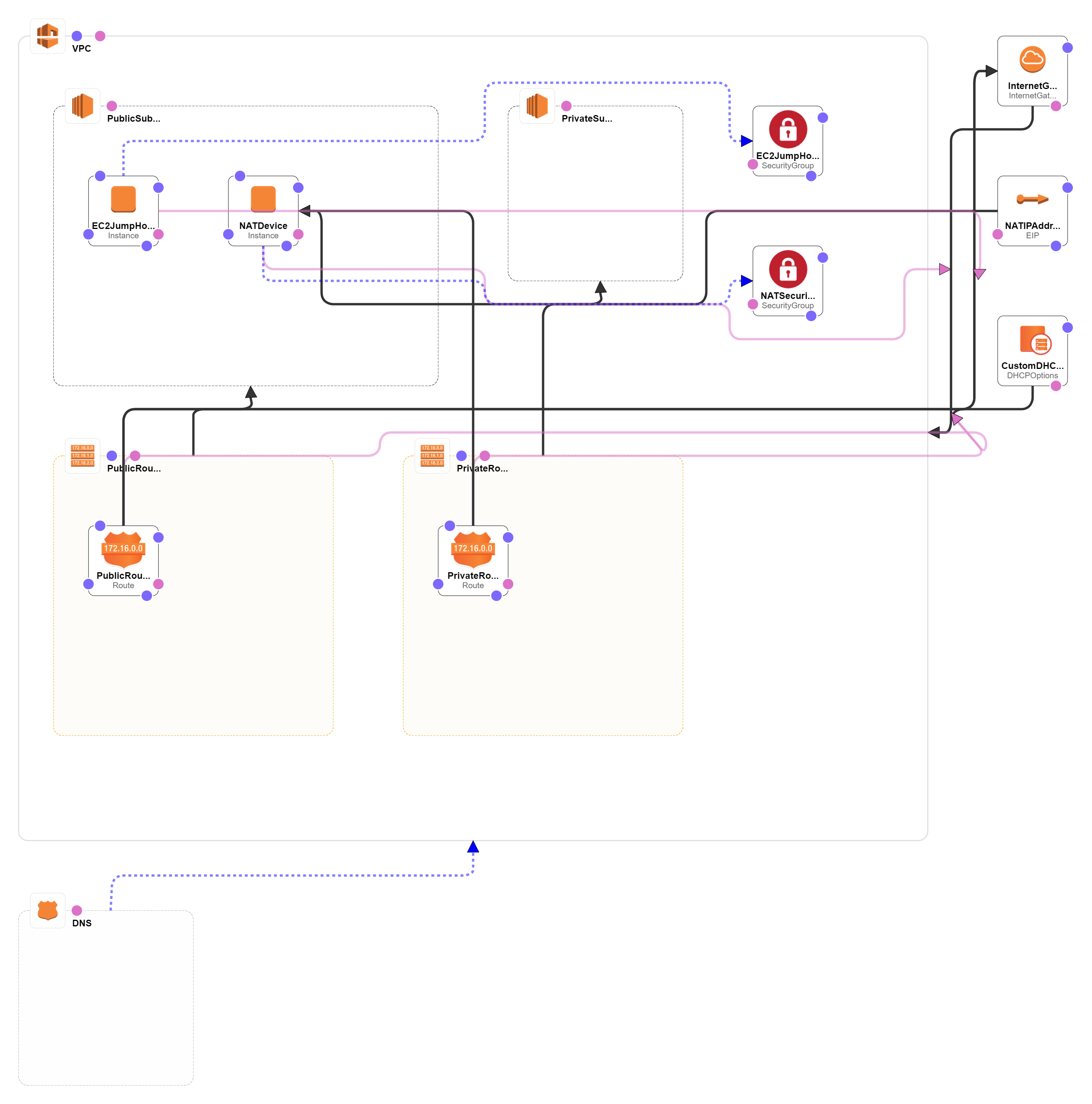Deploying a pair of public and private subnets with a NAT instance, and an optionally Splunk Enterprise instance within a VPC.
This template launch stacks with the following infrastructure depending on the options chosen during the CF stack creations.
VPC with NAT instance, 2 subnets, a jumphost (bastion host), a private hosted DNS name, and a Splunk Enterprise instance.
A template can be used repeatedly to create identical copies of the same stack (or to use as a foundation to start a new stack). Templates JSON-formatted text files . With CloudFormation, you can see exactly which AWS resources make up a stack. You retain full control and have the ability to modify any of the AWS resources created as part of a stack.
The templates below are included in this repository (cloudform)
| Template | Description |
|---|---|
| master_infrastructure.template | This is the master template - deploy it to AWS CloudFormation and it will also launch another netsted stack to launch a Splunk Enterprise Instance if Splunk instance creation is opted. This template also deploys a VPC with a pair of public and private subnets in an Availability Zone. It deploys an Internet gateway, with a default route on the public subnets. It deploys a NAT instance, private hosted DNS name in AWS Route 53 if the private DNS name is provided during stack creation, a bastion host, and default routes for them in the private subnets |
| splunk_server.template | This template deploys a Splunk Enterprise instance launched by master_infrastructure.template with required security groups when Splunk instance creation is opted |
| vpc-nat-jumphost.template | This template deploys a VPC with a pair of public and private subnets in an Availability Zone. It deploys an Internet gateway, with a default route on the public subnets. It deploys a NAT instance, private hosted DNS name in AWS Route 53, a bastion host, and default routes for them in the private subnets without launching a Splunk Enterprise instance so this stack can be used to as the infrastructure stack for simple workloads |
After the CloudFormation templates have been deployed, the stack outputs will list all required details to start to interact with bastion host, NAT instance, and Splunk Enterprise instance.
- Forking this GitHub repository.
- Clone the forked GitHub repository to your local machine.
- Modify the templates appropriately.
- Upload the templates to an Amazon S3 bucket of your choice. If you launch the stack from this README, you will be launching the stack from current S3 bucket.
- Either create a new CloudFormation stack by deploying the master_infrastructure template, or update your existing stack with your version of the templates.
By default, Amazon Linux AMI instances are used, but you can change this by modifying the following section:
...
"AWSRegionArch2AMI" : {
"us-east-1" : {"PV64" : "ami-2a69aa47", "HVM64" : "ami-6869aa05", "HVMG2" : "ami-2e5e9c43"},
"us-west-2" : {"PV64" : "ami-7f77b31f", "HVM64" : "ami-7172b611", "HVMG2" : "ami-83b770e3"},
"us-west-1" : {"PV64" : "ami-a2490dc2", "HVM64" : "ami-31490d51", "HVMG2" : "ami-fd76329d"},
"eu-west-1" : {"PV64" : "ami-4cdd453f", "HVM64" : "ami-f9dd458a", "HVMG2" : "ami-b9bd25ca"},
"eu-central-1" : {"PV64" : "ami-6527cf0a", "HVM64" : "ami-ea26ce85", "HVMG2" : "ami-7f04ec10"},
"ap-northeast-1" : {"PV64" : "ami-3e42b65f", "HVM64" : "ami-374db956", "HVMG2" : "ami-e0ee1981"},
"ap-northeast-2" : {"PV64" : "NOT_SUPPORTED", "HVM64" : "ami-2b408b45", "HVMG2" : "NOT_SUPPORTED"},
"ap-southeast-1" : {"PV64" : "ami-df9e4cbc", "HVM64" : "ami-a59b49c6", "HVMG2" : "ami-0cb5676f"},
"ap-southeast-2" : {"PV64" : "ami-63351d00", "HVM64" : "ami-dc361ebf", "HVMG2" : "ami-a71c34c4"},
"ap-south-1" : {"PV64" : "NOT_SUPPORTED", "HVM64" : "ami-ffbdd790", "HVMG2" : "ami-f5b2d89a"},
"sa-east-1" : {"PV64" : "ami-1ad34676", "HVM64" : "ami-6dd04501", "HVMG2" : "NOT_SUPPORTED"},
"cn-north-1" : {"PV64" : "ami-77559f1a", "HVM64" : "ami-8e6aa0e3", "HVMG2" : "NOT_SUPPORTED"}
},
...
This set of templates deploys the following network address design:
| Item | CIDR Range | Usable IPs | Description |
|---|---|---|---|
| VPC | 10.0.0.0/16 | 65,536 | The whole range used for the VPC and all subnets |
| Public Subnet | 10.0.0.0/24 | ~4000 | The public subnet |
| Private Subnet | 10.0.1.0/24 | ~4000 | The private subnet |
You can adjust the CIDR ranges used in this section of the master_template.template template:
...
"Mappings" : {
"SubnetConfig" : {
"VPC" : { "CIDR" : "10.0.0.0/16" },
"Public" : { "CIDR" : "10.0.0.0/24" },
"Private" : { "CIDR" : "10.0.1.0/24"}
},
...
This master_infrastructure.template deploys the the stack from a S3 bucket named cybersociety in ap-southeast-2 region. You can modify the S3 bucket name and the additional template files for subsequent nested stack created by master_infrastructure.template by changing this section of master_infrastructure.template
...
"SplunkServer" : {
"Type" : "AWS::CloudFormation::Stack",
"Metadata" : {
"Comment" : "Splunk Server in Private Subnet."
},
"DependsOn" : "VPC",
"Properties" : {
"TemplateURL" : "https://cybersociety.s3.amazonaws.com/cf-templates/splunk_server.template",
"Parameters" : {
"VpcId" : { "Ref" : "VPC"},
"SubnetId" : { "Ref" : "PrivateSubnet" },
"KeyName" : { "Ref" : "KeyName" },
"SplunkAdminPassword" : { "Ref" : "SplunkAdminPassword" },
"SplunkInstanceType" : { "Ref" : "SplunkInstanceType"}
}
}
}
...
See forking instruction.


